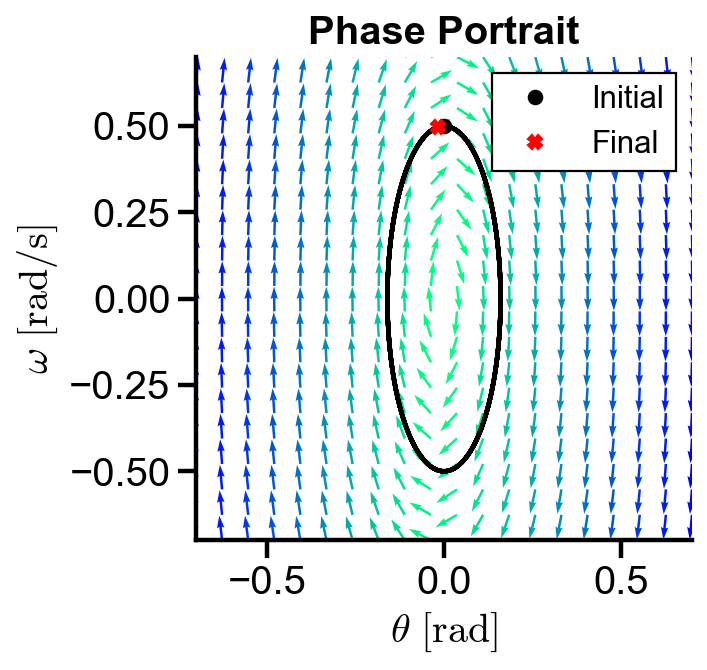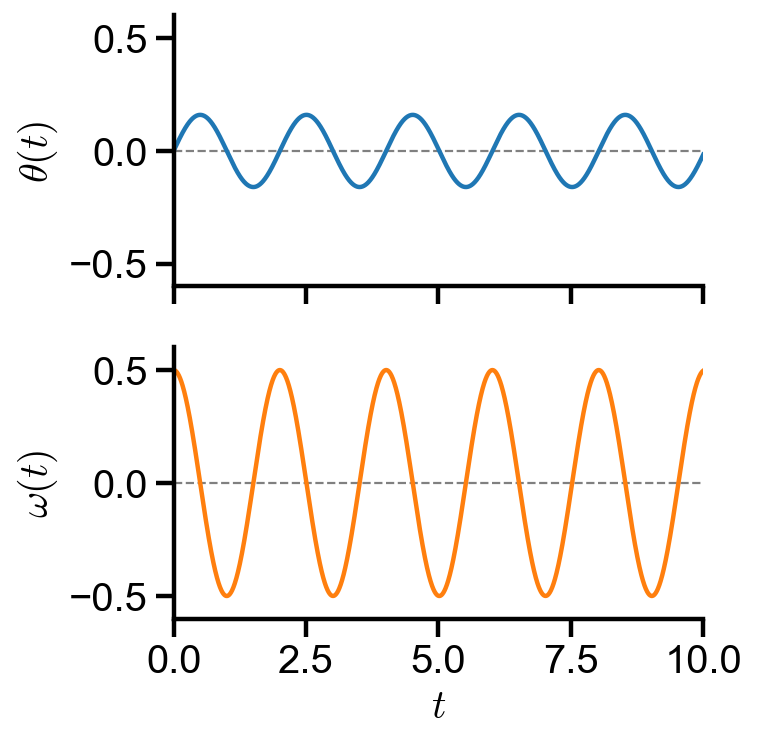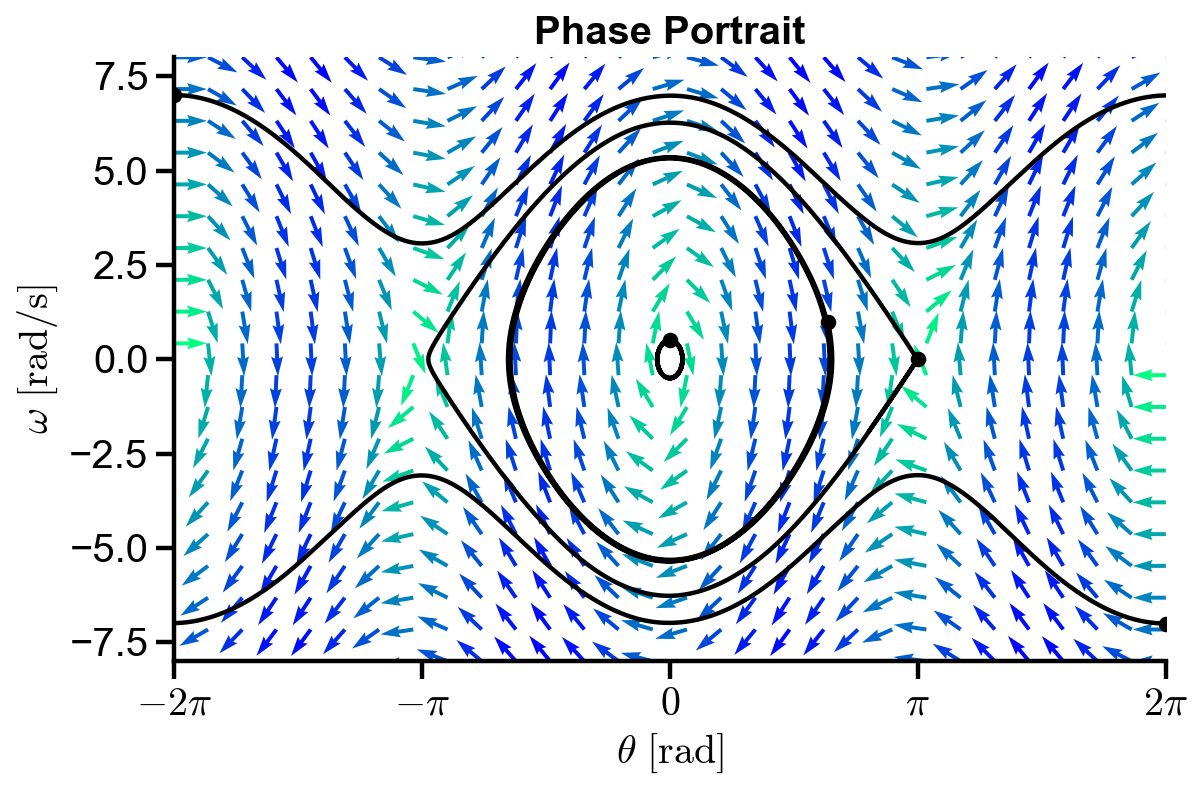Linear and Nonlinear Pendulums#
Teng-Jui Lin
Content adapted from UW AMATH 301, Beginning Scientific Computing, in Spring 2020.
Phase portraits
Linear pendulum
Nonlinear pendulum
Linear pendulum#
The motion of a linear pendulum at small angles can be described by the linear second-order ODE
where
Problem Statement. Solve the system of ODEs using scipy.integrate.solve_ivp() in
import numpy as np
import matplotlib.pyplot as plt
import scipy
from scipy import integrate
# define physical constants
g = 9.8
l = 1
# define time array
t_initial = 0
t_final = 10
dt = 0.005
t = np.arange(t_initial, t_final+dt/2, dt)
t_len = len(t)
# define initial conditions
initial_val = np.array([0, 0.5])
# define ode system
dtheta_dt = lambda theta, omega : omega
domega_dt = lambda theta, omega: -g/l*theta
ode_syst = lambda t, z : np.array([dtheta_dt(*z), domega_dt(*z)])
# solve ode system
ode_soln = scipy.integrate.solve_ivp(ode_syst, [t_initial, t_final], initial_val, t_eval=t).y
# plot settings
%config InlineBackend.figure_format = 'retina'
%matplotlib inline
plt.rcParams.update({
'font.family': 'Arial', # Times New Roman, Calibri
'font.weight': 'normal',
'mathtext.fontset': 'cm',
'font.size': 18,
'lines.linewidth': 2,
'axes.linewidth': 2,
'axes.spines.top': False,
'axes.spines.right': False,
'axes.titleweight': 'bold',
'axes.titlesize': 18,
'axes.labelweight': 'bold',
'xtick.major.size': 8,
'xtick.major.width': 2,
'ytick.major.size': 8,
'ytick.major.width': 2,
'figure.dpi': 80,
'savefig.dpi': 300,
'legend.framealpha': 1,
'legend.edgecolor': 'black',
'legend.fancybox': False,
'legend.fontsize': 14
})
# quiver grid
theta_vec = np.linspace(-0.7, 0.7, 20)
omega_vec = np.linspace(-0.7, 0.7, 20)
Theta, Omega = np.meshgrid(theta_vec, omega_vec)
fig, ax = plt.subplots(figsize=(4, 4))
# phase portrait
scale = np.sqrt(dtheta_dt(Theta, Omega)**2 + domega_dt(Theta, Omega)**2)
ax.quiver(Theta, Omega, dtheta_dt(Theta, Omega)/scale, domega_dt(Theta, Omega)/scale, scale, cmap='winter_r', scale=20, width=0.005) # regular
ax.plot(*initial_val, 'o', color='black', label='Initial')
ax.plot(*ode_soln, color='black')
ax.plot(*ode_soln[:, -1], 'X', color='red', label='Final')
# plot settings
ax.set_xlabel('$\\theta \ [\mathrm{rad}]$')
ax.set_ylabel('$\omega \ [\mathrm{rad/s}]$')
ax.set_title('Phase Portrait')
ax.set_xlim(-0.7, 0.7)
ax.set_ylim(-0.7, 0.7)
ax.legend(loc='upper right')
<matplotlib.legend.Legend at 0x211468cd3c8>

▲ The figure above shows the phase portrait of a linear pendulum at small angles. The trajectory forms a close loop, indicating continued oscillatory behavior over time. Note that this only holds true for small angles due to small angle approximation.
fig, axs = plt.subplots(2, 1, figsize=(5, 5), sharex=True)
axs[0].plot(t, ode_soln[0], color='tab:blue', label='$\\theta(t)$')
axs[1].plot(t, ode_soln[1], color='tab:orange', label='$\omega(t)$')
axs[1].set_xlabel('$t$')
axs[0].set_ylabel('$\\theta(t)$')
axs[1].set_ylabel('$\omega(t)$')
for i in range(2):
axs[i].plot([0, 30], [0, 0], '--', color='grey', lw=1, zorder=0)
# # plot settings
axs[i].set_xlim(t[0], t[-1])
axs[i].set_ylim(-0.6, 0.6)
plt.tight_layout()

▲ The figure above shows the angle and angular velocity of a linear pendulum at small angles. Both of them oscillates sinusoidally without damping.
Nonlinear pendulum#
The motion of a pendulum without small angle approximation can be described by the nonlinear second-order ODE
where
Problem Statement. Solve the system of ODEs using scipy.integrate.solve_ivp() in
Plot the phase portrait of the solution.
# define physical constants
g = 9.8
l = 1
# define time array
t_initial = 0
t_final = 10
dt = 0.005
t = np.arange(t_initial, t_final+dt/2, dt)
t_len = len(t)
# define initial conditions
initial_vals = np.array([[0, 0.5], [2, 1], [np.pi, -1e-4], [2*np.pi, -7], [-2*np.pi, 7]])
# define ode system
dtheta_dt = lambda theta, omega : omega
domega_dt = lambda theta, omega: -g/l*np.sin(theta)
ode_syst = lambda t, z : np.array([dtheta_dt(*z), domega_dt(*z)])
# quiver grid
theta_vec = np.linspace(-2*np.pi, 2*np.pi, 30)
omega_vec = np.linspace(-8, 8, 20)
Theta, Omega = np.meshgrid(theta_vec, omega_vec)
fig, ax = plt.subplots(figsize=(8, 5))
for i in range(len(initial_vals)):
# solve ode system
ode_soln = scipy.integrate.solve_ivp(ode_syst, [t_initial, t_final], initial_vals[i], t_eval=t).y
# plot trajectory
ax.plot(*initial_vals[i], 'o', color='black', label='Initial')
ax.plot(*ode_soln, color='black')
# slope field
scale = np.sqrt(dtheta_dt(Theta, Omega)**2 + domega_dt(Theta, Omega)**2)
ax.quiver(Theta, Omega, dtheta_dt(Theta, Omega)/scale, domega_dt(Theta, Omega)/scale, scale, cmap='winter_r', scale=30, width=0.004) # regular
# plot settings
ax.set_xlabel('$\\theta \ [\mathrm{rad}]$')
ax.set_ylabel('$\omega \ [\mathrm{rad/s}]$')
ax.set_title('Phase Portrait')
ax.set_xlim(-2*np.pi, 2*np.pi)
ax.set_ylim(-8, 8)
plt.xticks([-2*np.pi, -np.pi, 0, np.pi, 2*np.pi], ['$-2\pi$', '$-\pi$', '$0$', '$\pi$', '$2\pi$']);

▲ The figure above shows the behavior of a nonlinear pendulum.
The trajectories for small initial angle and velocity forms a closed loop, with both angle and velocity changing signs, indicating continued oscillatory behavior of the pendulum over time. The behavior of linear pendulum is also replicated as shown in the smallest loop at the center.
The trajectories for large initial angles and/or large initial velocity gives oscillating velocity about angles, but its sign is not changing, indicating that the pendulum is rotating in one direction.

